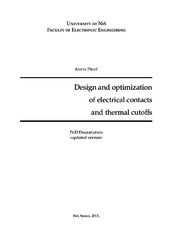Приказ основних података о дисертацији
Design and optimization of electrical contacts and thermal cutoffs
| dc.contributor.advisor | Pešić, Biljana | |
| dc.creator | Prijić, Aneta | |
| dc.date.accessioned | 2016-01-05T13:21:34Z | |
| dc.date.available | 2016-01-05T13:21:34Z | |
| dc.date.available | 2020-07-03T16:02:54Z | |
| dc.date.issued | 2007-12-26 | |
| dc.identifier.uri | http://eteze.ni.ac.rs/application/showtheses?thesesId=1664 | |
| dc.identifier.uri | https://nardus.mpn.gov.rs/handle/123456789/3891 | |
| dc.identifier.uri | https://fedorakg.kg.ac.rs/fedora/get/o:924/bdef:Content/download | |
| dc.identifier.uri | http://vbs.rs/scripts/cobiss?command=DISPLAY&base=70052&RID=533068182 | |
| dc.description.abstract | This Dissertation is focused on the design and optimization of the two types of metal based switching devices: rivet electrical contacts and S–type thermal cutoffs. Theoretical basis of the electrical contacts design is employed for the adequate contact material selection, determination of the proper set of contact geometry and dimensions, and estimation of the minimum contact force value. Contacts of the solid and clad type, with rounded head are considered within two supporting structures. Obtained results of 3–D simulation of mechanical, electrical and thermal characteristics of the selected contacts in a steady state regime are presented. Simulations are carried out in the coupled physical domains by the direct solving method. Special emphasis is put on the dependencies of the operating temperature and maximum equivalent stress in the contacts under various working conditions. On the basis of the obtained results, optimization of the rivet electrical contacts is realized by the appropriate selection of the contact material, determination of the geometry and dimensions of contacts and definition of the rated current value. The optimization was conducted by functional, economic, ecological and reliability issues. Feasibility of contacts implementation into the specific switching devices with predefined rated currents and number of switching cycles before the failure are outlined. Analyzed dependencies and optimization results are described in details. Theoretical basis of design and optimization procedures of thermal cutoffs are summarized. Parameters of functionality, quality and reliability are specially considered, since they are crucial for the appropriate choice of geometry, dimensions and materials of cutoffs constitutive elements. Thermodynamic and microstructure characterization of the low melting alloys for thermal cutoffs purposes are elaborated. A new method for evaluation of the liquidus surfaces of the ternary systems is proposed. It is based on the standard 3–D surface modeling principles, and is applicable for any ternary system whose phase diagrams of binary subsystems and a few appropriate experimental points are known. The liquidus temperature can be determined from this 3–D surface by geometrical rules for any arbitrary composition of the ternary system. Moreover, the range of compositions of ternary alloys that have desired liquidus temperature can be easily extracted. Microstructure characteristics of the two eutectic low–melting alloys are also presented. Investigation was performed by SEMand EDS techniques, and the obtained results are discussed from the aspects of thermal cutoff technology development. The results of 3–D electrical and thermal simulation of thermal cutoffs with two cutoff temperatures for the rated current of 12 A and rated voltage of 250 V (S–95 and S–138 type) are analyzed. The functionality and quality parameters of thermal cutoffs are determinedby the simulation. Optimization of thermal cutoffs geometry anddimensions is proposed considering functional, economic and technological aspects. The results of electro–thermal characteristics investigation of S–138 thermal cutoff industrial prototypes by the thermovision imaging are presented. Thermal boundary conditions for the simulation, which are crucial for the successful optimization of the cutoffs, are set according to the obtained results. On the basis of the temperature distributions in the cutoffs under different working conditions, the temperature rise due to the self–heating is registered, the cutoff temperature is determined, and the response time of the cutoffs is evaluated. Thermal characteristics of the housing and conductive elements of the cutoffs are also analyzed. As a result of the performed design and optimization procedures of thermal cutoffs, a technology line for their industrial production is presented. Complete process flow diagram for the S–type cutoffs is proposed. It includes preparation and assembling of the constitutive elements and quality and reliability testing procedures. | en |
| dc.format | application/pdf | |
| dc.language | en | |
| dc.publisher | Универзитет у Нишу, Електронски факултет | sr |
| dc.rights | openAccess | en |
| dc.rights.uri | https://creativecommons.org/licenses/by/4.0/ | |
| dc.source | Универзитет у Нишу | sr |
| dc.subject | Electrical contacts | en |
| dc.subject | Thermal cutoffs | en |
| dc.title | Design and optimization of electrical contacts and thermal cutoffs | en |
| dc.type | doctoralThesis | en |
| dc.rights.license | BY | |
| dcterms.abstract | Биљана Пешић; Пријић, Aнета; | |
| dc.identifier.fulltext | https://nardus.mpn.gov.rs/bitstream/id/52373/bitstream_52373.pdf | |
| dc.identifier.doi | 10.2298/ni20071226prijic | |
| dc.identifier.rcub | https://hdl.handle.net/21.15107/rcub_nardus_3891 |


